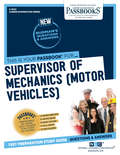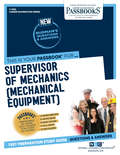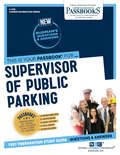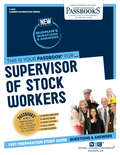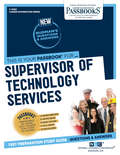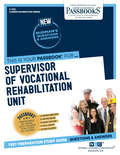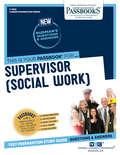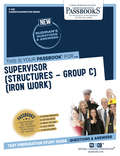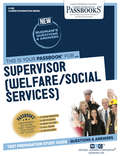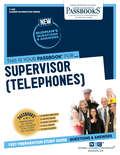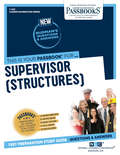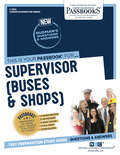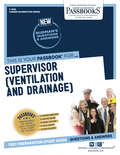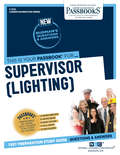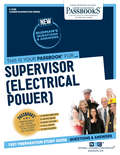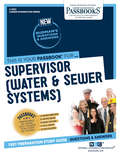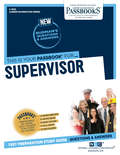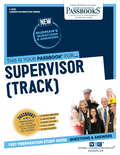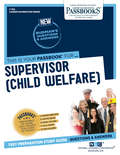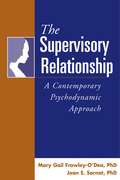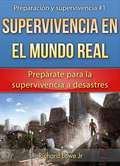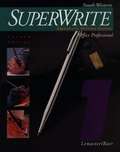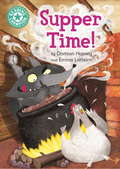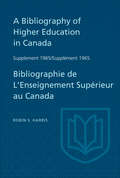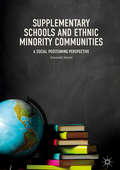- Table View
- List View
Supervisor of Mechanics: Passbooks Study Guide (Career Examination Series)
by National Learning CorporationThe Supervisor of Mechanics (Motor Vehicles) Passbook® prepares you for your test by allowing you to take practice exams in the subjects you need to study. It provides hundreds of questions and answers in the areas that will likely be covered on your upcoming exam.
Supervisor of Mechanics: Passbooks Study Guide (Career Examination Series)
by National Learning CorporationThe Supervisor of Mechanics (Mechanical Equipment) Passbook® prepares you for your test by allowing you to take practice exams in the subjects you need to study. It provides hundreds of questions and answers in the areas that will likely be covered on your upcoming exam.
Supervisor of Public Parking: Passbooks Study Guide (Career Examination Series)
by National Learning CorporationThe Supervisor of Public Parking Passbook® prepares you for your test by allowing you to take practice exams in the subjects you need to study. It provides hundreds of questions and answers in the areas that will likely be covered on your upcoming exam.
Supervisor of Stock Workers: Passbooks Study Guide (Career Examination Series)
by National Learning CorporationThe Supervisor of Stock Workers Passbook® prepares you for your test by allowing you to take practice exams in the subjects you need to study. It provides hundreds of questions and answers in the areas that will likely be covered on your upcoming exam.
Supervisor of Technology Services: Passbooks Study Guide (Career Examination Series)
by National Learning CorporationThe Supervisor of Technology Services Passbook® prepares you for your test by allowing you to take practice exams in the subjects you need to study. It provides hundreds of questions and answers in the areas that will likely be covered on your upcoming exam, including but not limited to: administration; IT supervision; project administration; systems analysis and design; and more.
Supervisor of Vocational Rehabilitation Unit: Passbooks Study Guide (Career Examination Series)
by National Learning CorporationThe Supervisor of Vocational Rehabilitation Unit Passbook® prepares you for your test by allowing you to take practice exams in the subjects you need to study. It provides hundreds of questions and answers in the areas that will likely be covered on your upcoming exam, including but not limited to; Administrative techniques and practices; Organization and administration of a vocational rehabilitation services program; Clinical supervision and guidance of rehabilitation program staff; and more.
Supervisor: Passbooks Study Guide (Career Examination Series #C-1052)
by National Learning CorporationThe Supervisor (Social Work) Passbook® prepares you for your test by allowing you to take practice exams in the subjects you need to study. It provides hundreds of questions and answers in the areas that will likely be covered on your upcoming exam.
Supervisor: Passbooks Study Guide (Career Examination Series #C-3510)
by National Learning CorporationThe Supervisor (Structures-Group C) (Iron Work) Passbook® prepares you for your test by allowing you to take practice exams in the subjects you need to study. It provides hundreds of questions and answers in the areas that will likely be covered on your upcoming exam, including but not limited to: Construction, maintenance, installation, repair, alteration, and inspection of structural and ornamental ironwork components; Supervisory skills and techniques; Assigning, reviewing, and evaluating the work of subordinates; Technical aspects of the ironwork trade; and more.
Supervisor: Passbooks Study Guide (Career Examination Series #C-3510)
by National Learning CorporationThe Supervisor (Welfare/Social Services) Passbook® prepares you for your test by allowing you to take practice exams in the subjects you need to study. It provides hundreds of questions and answers in the areas that will likely be covered on your upcoming exam, including but not limited to: ability to efficiently and safely manage a central storeroom, or a group of satellite storerooms, or other major subdivisions of the stores division; ability to assign, review and evaluate the work of subordinates; knowledge of labor relations; technical knowledge of authority storeroom methods, systems and procedures; ability to plan for and supervise the orderly and efficient storage and distribution of materials; and more.
Supervisor: Passbooks Study Guide (Career Examination Series #C-3510)
by National Learning CorporationThe Supervisor (Telephones) Passbook® prepares you for your test by allowing you to take practice exams in the subjects you need to study. It provides hundreds of questions and answers in the areas that will likely be covered on your upcoming exam.
Supervisor: Passbooks Study Guide (Career Examination Series #C-3510)
by National Learning CorporationThe Supervisor (Structures) Passbook® prepares you for your test by allowing you to take practice exams in the subjects you need to study. It provides hundreds of questions and answers in the areas that will likely be covered on your upcoming exam.
Supervisor: Passbooks Study Guide (Career Examination Series #C-3510)
by National Learning CorporationThe Supervisor (Buses and Shops) Passbook® prepares you for your test by allowing you to take practice exams in the subjects you need to study. It provides hundreds of questions and answers in the areas that will likely be covered on your upcoming exam.
Supervisor: Passbooks Study Guide (Career Examination Series #C-3510)
by National Learning CorporationThe Supervisor (Ventilation and Drainage) Passbook® prepares you for your test by allowing you to take practice exams in the subjects you need to study. It provides hundreds of questions and answers in the areas that will likely be covered on your upcoming exam.
Supervisor: Passbooks Study Guide (Career Examination Series #C-3510)
by National Learning CorporationThe Supervisor (Lighting) Passbook® prepares you for your test by allowing you to take practice exams in the subjects you need to study. It provides hundreds of questions and answers in the areas that will likely be covered on your upcoming exam.
Supervisor: Passbooks Study Guide (Career Examination Series #C-3510)
by National Learning CorporationThe Supervisor (Electrical Power) Passbook® prepares you for your test by allowing you to take practice exams in the subjects you need to study. It provides hundreds of questions and answers in the areas that will likely be covered on your upcoming exam.
Supervisor: Passbooks Study Guide (Career Examination Series #C-3510)
by National Learning CorporationThe Supervisor (Water & Sewer Systems) Passbook® prepares you for your test by allowing you to take practice exams in the subjects you need to study. It provides hundreds of questions and answers in the areas that will likely be covered on your upcoming exam, including but not limited to: supervision; water distribution systems and fire hydrants; installing, repairing and servicing fire hydrants, valves and water service boxes and maintaining water lines; sanitary and storm sewer systems; sewer system safety and trenching practices; understanding and interpreting technical information and construction and site plans; and more.
Supervisor: Passbooks Study Guide (Career Examination Series #C-3510)
by National Learning CorporationThe Supervisor Passbook® prepares you for your test by allowing you to take practice exams in the subjects you need to study. It provides hundreds of questions and answers in the areas that will likely be covered on your upcoming exam.
Supervisor: Passbooks Study Guide (Career Examination Series #C-3546-9)
by National Learning CorporationThe Supervisor (Track) Passbook® prepares you for your test by allowing you to take practice exams in the subjects you need to study. It provides hundreds of questions and answers in the areas that will likely be covered on your upcoming exam.
Supervisor: Passbooks Study Guide (Career Examination Series #C-784)
by National Learning CorporationThe Supervisor (Child Welfare) Passbook® prepares you for your test by allowing you to take practice exams in the subjects you need to study. It provides hundreds of questions and answers in the areas that will likely be covered on your upcoming exam, including but not limited to; Social services supervision including staff training and development; Performance evaluation; Problem solving and decision making; Preparation and interpretation of written material; and more.
Supervisory Relationship
by Mary E. Sarnat Mary Gail Frawley-O'DeaIn the past two decades, many psychodynamic therapists have begun to view the relational processes taking place between patient and therapist as a central source of transformation. Yet traditional paradigms of clinical supervision, focusing primarily on didactic teaching, have limitations for training therapists to work in these new ways. This groundbreaking volume is the first to elaborate a comprehensive contemporary model of supervision. Using a wealth of examples and vignettes, the authors show how working within the vicissitudes of the supervisory relationship can allow the supervisee to gain a deeper understanding of the treatment method being taught. Key topics discussed include issues of power and authority, regression in the supervisory relationship, rethinking the "teach/treat" question, parallel process as a relational phenomenon, working with group process in case conference, and the role of the organization in supporting training. This is a richly informative resource for psychologists, psychiatrists, social workers, psychoanalysts, and others involved in clinical supervision and training. It also will serve as a text for courses in supervision and organizational psychology.
Supervivencia en el mundo real: Prepárate para la supervivencia a desastres
by Richard G Lowe Jr Vanessa Pérez RodríguezSupervivencia en el mundo real: Prepárate para la supervivencia a desastres por Richard G Lowe Jr ¿Y si pudieras mejorar drásticamente tus posibilidades de sobrevivir a un gran desastre? Seguridad para ti y tu familia sin tirar la casa por la ventana. ¿Y si pudieras mejorar drásticamente tus posibilidades de sobrevivir a un gran desastre? Imagínate que puedes asegurar que tus hijos y otros familiares están a salvo después del "gran terremoto" o de un huracán. Imagina cómo te sentirías siendo el único en tu vecindario con suficiente comida y agua. El especialista en recuperación de desastres y entrenado a través del Equipo Comunitario de Respuesta a las Emergencias (CERT en inglés), Richard Lowe, te explica cómo hacer que tú, tu familia y tus amigos estéis preparados ante cualquier desastre, ya sea pequeño o grande. Basado en su entrenamiento especializado, en entrevistas con expertos y en su experiencia personal, Lowe contesta la gran pregunta: ¿cuál es el secreto para mejoras las posibilidades de supervivencia incluso después de un gran desastre? Con este libro aprenderás: Por qué no puedes depender de los cuerpos de bomberos y de policía durante un desastre, y qué hacer en ese caso Cómo puede mantenerte a salvo a ti, a tu familia y a tus hijos el saber más ¿Realmente sabes qué tipos de desastres pueden ocurrir en tu zona? Aprenderás a descubrirlo Cómo crear un plan de desastres que realmente funcione Cómo asegurarte de que tu familia y tus hijos entiendan qué hacer durante un desastre Cómo hacer saber a otras personas que tú y tu familia estáis a salvo Cómo preparar tu casa para las emergencias Qué tipo de comida, agua y otras provisiones se necesitan Cómo prepararte para las salidas o viajes Qué hacer cuando se desata el desastre Cómo crear una "bolsa de viaje" Qué hacer cuando tienes que evacuar la zona Compra este libro AH
Superwrite: Alphabetic Writing System, Office Professional (Volume 1, 2nd Edition)
by A. James Lemaster John BaerVolume One introduces SuperWrite theory and beginning transcription principles. The step-by-step approach to writing principles guides students to alphabetic writing success. Eight lessons develop personal success factors such as goal-setting, problem-solving, time management, attendance, and promptness. Updated keyboarding style references reflect current business practices.
Supper Time!: Independent Reading Turquoise 7 (Reading Champion #694)
by Damian HarveyWolf is hungry and he fancies chicken for supper. But the little chicken doesn't fancy being eaten at all!Reading Champion offers independent reading books for children to practise and reinforce their developing reading skills.Fantastic, original stories are accompanied by engaging artwork and a reading activity. Each book has been carefully graded so that it can be matched to a child's reading ability, encouraging reading for pleasure.Independent Reading Turquoise 7 stories are perfect for children aged 5+ who are reading at book band 7 (Turquoise) in classroom reading lessons.
Supplement 1965 to A Bibliography of Higher Education in Canada / Supplément 1965 de Bibliographie de L'Enseighnement Supérieur au Canada
by Robin HarrisThis Supplement to the 1960 Bibliography by Harris and Tremblay adds some 3,500 entries to the approximately 4,000 listed in the first volume, providing a full list of articles, books, pamphlets, and theses bearing on all aspects of higher education in Canada for the period 1959-1963. The organization of the earlier volume has been maintained with slight modifications, and some new sections have been added, including one devoted to institutions which, although they are post-secondary, do not grant degrees; and one which includes plays and novels set wholly or in part in actual or fictitious Canadian universities. (Studies in Higher Education in Canada, No. 3)
Supplementary Schools and Ethnic Minority Communities: A Social Positioning Perspective
by Amanda SimonThis book provides a unique perspective into the world of supplementary schooling, exploring both the social positioning of these schools and the ethnic minority communities they serve. The author presents a close examination of the establishment and functioning of supplementary schools which offers a fresh and novel insight into acculturation processes. Drawing on empirical data gathered from staff interviews, classroom observations and interactive recordings, this book explores the operation of supplementary schools as sites of identity construction where the community identities are preserved, defended, renegotiated and reconstructed. The various modes of construction are indicative of the acculturation experiences of ethnic minority communities and the ways in which these communities negotiate residence in one country whilst having roots in another. This book therefore offers a revealing conceptualization of supplementary schools, not merely as educational spaces, but socio-political enterprises that are situated within and respond to various historical, social and political contexts. This pioneering work will appeal to students and scholars in the fields of education, migration and identity.
